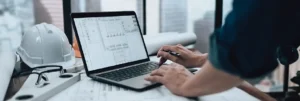The design of the new 333 Dexter mixed-use office building in Seattle, Washington, creates a vibrant, pedestrian-oriented streetscape at the nexus of two previously disconnected neighborhoods.
Designed by The Miller Hull Partnership, the project includes two towers which complement each other with similar materials, utilizing both a high-performance curtain wall system and profiled metal panel building skin. The north tower’s punched windows and industrial palette of glass, steel, brick, and profiled metal panel is a modern take on the turn-of-the-century brick warehouse vernacular prevalent in the South Lake Union neighborhood in the early 1900s. The south towerʼs rhythmic pattern of corrugated metal panel and glass evokes a sense of movement, reflecting the importance of this active site along Aurora Avenue and the new Lake2Bay pedestrian corridor.
With a glazing ratio and open-air roof decks, the certified Leadership in Energy and Environmental Design (LEED) Gold project visually connects tenants to the water, mountains, and neighborhood from all points.
This project is part of Miller Hull’s Emission Zero initiative, a program announced in 2021 combining the firm’s actions through design, ongoing efforts to educate and advocate, and a commitment to offset the greenhouse gas emissions released up to the point of occupancy for all built projects.
Using a tool to calculate upfront embodied carbon emissions determines the amount of carbon offsets to purchase for each project upon completion. The total upfront embodied carbon impact of 333 Dexter’s structure, enclosure, and interiors was calculated at 30,025 tonnes of carbon dioxide equivalent (tCO2e).
As one of the last remaining full-block sites in the area, the 58,714 m2 (632,000 sf) building is completely changed to better reflect the urban condition envisioned for the area and provide Seattle with thousands of high-tech and retail jobs.




Responses